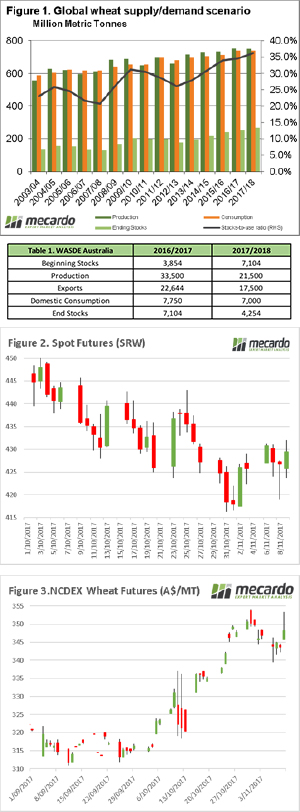WASDE & Indian barriers

 The US Department of Agriculture released their World Agricultural Supply and Demand Estimates overnight. In this week’s comment, we will take a look at the impact on wheat, and report on new import barriers being erected in India.
The US Department of Agriculture released their World Agricultural Supply and Demand Estimates overnight. In this week’s comment, we will take a look at the impact on wheat, and report on new import barriers being erected in India.
In last week’s comment, I mentioned that this report would be released, and that there would be little in the way of surprises. This has largely been the case, with no major changes occurring. Unsurprisingly, the Russian crop was further increased by 1mmt, to a record wheat harvest of 83mmt. All in all, without beating around the bush, we are still in a world with a glut of wheat (fig 1). There are arguments that a large proportion of this stock is in China and not available to the export market, however the reality is that global prices are likely to stay depressed for some time.
The USDA have a relatively poor performance when it comes to forecasting Australia, and we tend to believe that the WASDE is usually around 2 months out of sync with reality. In table 1, the WASDE details for Australia are detailed. The items which stand out for future revision for me are:
- Beginning stocks: These are likely too high, and after such a strong export program this is likely to be revised back close to 5-5.5mmt.
- Production: USDA remain on the high end of the spectrum when it comes to Australian forecasts. A final production figure closer to 7mmt is more likely.
- Exports: An export program of 17.5mmt is extremely ambitious for the coming year, and when production and beginning stocks are brought back to reality will be a hard task to complete.
- Domestic consumption: The domestic consumption figure is sitting on the previous ten-year average, however this year there are a record number of cattle on feed.
So how did the WASDE report impact the markets? The answer is unfortunately for growers is minimally (figure 2). There was little in the way of surprises, and the report largely met trade expectations. After some short covering in the lead up to the report, the market regained it’s losses and is 5¢/bu or A$1 higher than this time last week.
A couple of weeks ago I flagged in the comment, “An Indian Summer”, that the Indian government was likely to implement a 20-25% import duty on wheat. In the past two days, the import duty on wheat was set to 20%. This is in place to discourage imports of wheat, and give positive price signals to local growers. In figure 3, Indian wheat futures on the NCDEX exchange are plotted, and we can see that yesterday the market started the day at A$345 shortly hitting A$353, and ending the day up A$3.
Although we don’t regularly examine pulse markets, a massive duty of 50% has been applied to peas. This is largely to disrupt the import from Canada, but for pea growers in Australia this will be felt.
What does this mean?
The November report is out of the way, and the December report is largely void of any worth. This means that by now and February the only influences on the global market from a fundamental point of view with any value will come from either Australia or South America.
We are going to have to wait until the northern hemisphere weather risk period to see any substantive rallies in the futures market. This does however provide opportunities for consumers to hedge values, or for growers to take out long swap positions.


